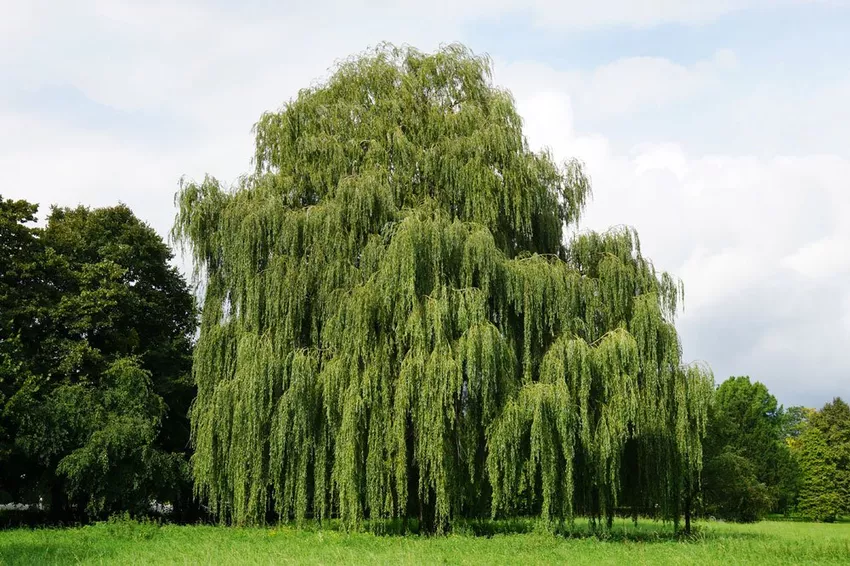In particular, fungal diseases can severely affect the weeping willow. We will show you which diseases can occur and how to treat them correctly.

The weeping willow (Salix alba Tristis) is one of the robust plants that is rarely attacked by diseases and pests. While weeping willow pests cannot actually be dangerous, some fungal diseases can damage the willow plant. This creates different types of damage, which require different countermeasures. While willow rust, for example, only shows visual impairments, diseases such as willow scab require the hobby gardener to intervene. Below you can find out which types of damage occur on the weeping willow and how they can be combated effectively.
❍ willow scab
If a weeping willow is affected by willow scab, it initially shows few abnormalities. Only individual parts of the plant appear discolored and thickened. However, the fungus spreads very quickly and without countermeasures, the entire tree can fall victim to it. If you fail to intervene, countermeasures will no longer help and the tree must be completely cleared.
Willow scab is caused by the fungus Pollaccia saliciperda. Leaves, twigs and shoot tips can be affected. Affected leaves wither and remain attached to the tree. If the fungus migrates from the leaves to the tips of the shoots, they turn black and die. This entire process only takes a few days. It is assumed that the fungus excretes toxins, which lead to the rapid discoloration of the shoots.
Infection usually occurs in early summer. The young leaves and shoots are particularly susceptible. The fungus can hibernate on fallen leaves or survive on diseased branches. In the spring, new spores are formed and new infections occur.
» Tip: All willow species can be affected. The Babylonian willow or the Salix Americana are particularly badly affected.
➛ What to do?
If the thickening mentioned at the beginning is visible, it can help to give the plant potassium and phosphorus immediately. The affected foliage is to be removed and closeddispose. It does not belong in the compost as the spores survive there. Burn the leaves or dispose of them with household waste. Special fungicides are used in the event of severe infestation.
Infested willows will often regenerate by producing new shoots.
❍ Marssonina Disease
This fungal disease also affects leaves, shoots and twigs. The disease can be recognized by growths up to three centimeters long on the young shoots. These dark sores burst open over time, suggesting hail damage to the crop. The pathogens also hibernate in the leaves and tree bark.
➛ What to do?
Diseased parts of the plant should be generously removed. The fallen leaves must be collected and disposed of completely. The spores survive on the compost and spread the disease further. Burn the leaves or dispose of them with household waste. Only in severe cases will it be necessary to use chemical pesticides.
❍ Shoot tip drought
Growths on the shoots can also indicate a shoot tip dryness. The fungus Marssonina saliciola is considered to be the cause of this disease. The spores overwinter on the leaves or on the ground. In the spring, the willow is then repeatedly infected.
➛ What to do?
All affected parts of the plant must be disposed of. Also collect all the leaves from the ground so that there are no new infections. The affected parts of the plant should be burned immediately. In severe cases, chemical fungicides are used.
❍ Galena
This fungal disease usually only affects young weeping willows. The disease can be recognized by the whitish shimmering parts of the plant. The trigger is the fungus Stereum purpureum. If the trees are not yet resilient enough or are already weakened, they are particularly susceptible to infection.
➛ What to do?
The diseased parts of the plant that shimmer like lead should be removed immediately. With additional doses of potassium and phosphorus, you strengthen the plant and accelerate regeneration. Since generally weakened plants are attacked more frequently, the administration of manganese and iron also contributes to general strengthening. Do not use commercial ready-made fertilizers, as these usually contain too much nitrogen.
» Tip: Do not use nitrogenous fertilizer.
❍ Preventing disease with proper care
Not every plant disease can get throughappropriate maintenance measures are prevented. Nevertheless, the fact is that plants that are already weakened are at an increased risk of being afflicted by diseases. You will get strong plants if you place the weeping willow in a sunny and free location. The plants feel most comfortable near bodies of water. Don't skimp on moisture. The soil should not dry out. You can also water extensively with the garden hose. One hour is the minimum.
The plants need nutrient-rich, loose soil. Regular composting gives the weeping willows the nutrients they need. The plants are sufficiently hardy and do not require additional protection. However, if you keep your weeping willow in a bucket, you have to be careful that it doesn't freeze through. It is better to overwinter the weeping willow in a cool room in the house and do not forget to water it a little every now and then. Even young plants need winter protection in the form of brushwood or leaves as a cover.
Weeping willows stay strong and he althy with these care measures:
❀ sunny location
❀ unique position
❀ regular watering
❀ sufficient nutrient supply
❀ winter protection for potted plants